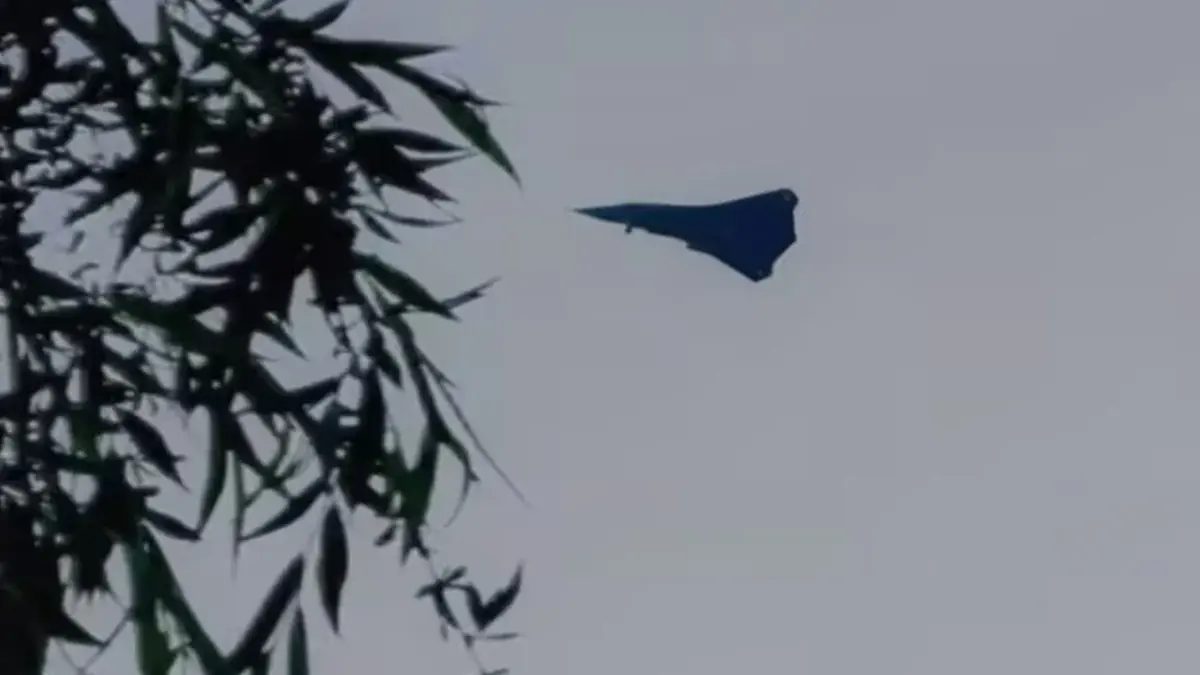Unconfirmed photographs circulating on Chinese social media platforms have revealed a new stealth aircraft with a tailless, delta-wing configuration and minimal visible external features. The design has immediately sparked debate among analysts and military observers as to whether the aircraft represents China’s latest sixth-generation fighter concept or a type of unmanned aerial combat system developed for collaborative operations with existing platforms.
The aircraft’s airframe features features reminiscent of modern low-observable designs, including a flat fuselage, blended wing body and the absence of vertical stabilizers. The most striking detail is the apparent lack of a traditional cockpit, fueling theories that the aircraft could be fully autonomous or alternatively piloted.
- These images of the mysterious sixth-generation aircraft leave its status as manned or unmanned unclear. (SCMP)
Specific theories: Fighter or drone?
Some analysts suggest that the aircraft could be part of China’s Chengdu J-36 or Shenyang J-50 programs, both sixth-generation initiatives considered focused on high-speed, stealth and unmanned teaming. Others interpret the new airframe as a dedicated loyal wingman drone, which would be paired with manned fighters. Designed to fly in formation, conduct electronic warfare, or perform high-risk missions such as SEAD (enemy air suppression). Defense).
The current configuration favors modularity and digital integration, allowing the aircraft to be quickly adapted for air superiority or support roles. While specific confirmation is lacking, the sheer variety of design features suggests that China is pursuing multiple sixth-generation architectures simultaneously – a strategic hedge that mirrors ongoing US and European efforts.
- Chengdu J-36 on a test flight. The J-36 is a speculative designation by analysts for a trijet, tailless, diamond double-delta wing aircraft in development by Chengdu Aircraft Corporation (CAC). China’s sixth-generation fighter As part of the program, this heavy stealth platform is intended for air superiority, strike, interception, and command and control in aircraft teaming operations. (Hurin/X)
Strategic and Doctrinal Implications
The timing of this emergence is not accidental. As the United States pushes ahead with its Next Generation Air Dominance (NGAD) program, and Europe develops its Future Combat Air System (FCAS), China appears to be signaling its strategic depth in future air warfare.
Whether manned or unmanned, the appearance of such an aircraft indicates a shift in PLA doctrine toward greater reliance on networked warfare and distributed air command structures. An advanced stealth platform capable of commanding UCAVs, jamming enemy radar, or delivering long-range strikes would add significant complexity to any adversary’s air defense strategy.
Furthermore, the potential development of a carrier-compatible version – if true – would provide a powerful force at sea. will allow projection. It would signal a leap in China’s ability to do so, bolstering its ambitions in disputed maritime territories.
Balancing innovation and reliability
Despite the intrigue, it remains uncertain whether the images represent an operational prototype, a testbed, or a scaled model. China has used carefully staged releases to shape external perceptions of its defense capabilities in the past. Without flight test confirmation or open acknowledgement from Beijing, the defense community remains cautious in its assessment.
However, even without official confirmation, the emergence of a third stealth configuration in less than two years signals China’s rapid pace in aerospace innovation. It also underscores the increasing centrality of autonomous systems, electronic warfare, and AI-assisted combat in future conflicts.
- Shenyang J-50 test flight. The J-50, also known as the J-XD or J-XDS, is a provisional designation for a twinjet, tailless lambda-wing aircraft developed by Shenyang Aircraft Corporation. It was seen during flight tests in Shenyang, China, in December 2024. (Eurasia Naval/Ex)
Outlook: A New Phase in the Stealth Race
The potential addition of a new sixth-generation platform—whether a frontline fighter or a support drone—has major implications for regional security and the global balance of air power. For the U.S. and its allies, the development is a reminder that China’s military modernization is no longer just advancing but is actively defining new operational paradigms.
As the world moves toward unmanned integration, loyal wingman concepts, and multi-domain command systems, Beijing’s next-generation aircraft, even in its speculative form, signals that the race for air superiority is entering a more complex and uncertain phase.
Rad More: Australia Selects Japan’s Mogami Frigate — A Milestone in Naval Strategy and Regional Influence
FAQs
The new aircraft has a tailless, delta-wing shape with no visible cockpit or vertical stabilizers. This design makes it more advanced and likely unmanned. Experts say it could be part of China’s sixth-generation fighter plans or a loyal wingman drone.
At present, this has not been confirmed. Some believe it is from the Chengdu J-36 or Shenyang J-50 fighter projects. Others believe it could be a drone designed to fly alongside manned jets for dangerous missions such as electronic warfare or enemy radar suppression.
The U.S. The timing coincides with the Next Generation Air Dominance (NGAD) program and Europe’s Future Combat Air System (FCAS). Now, by showing off the new design, China is signaling that it wants to compete directly in the global stealth and airpower competition.
If real, this aircraft would mark China’s move towards unmanned systems, AI in warfare, and networked air command. A carrier-based version could also increase its naval power in disputed territories, adding pressure on the US and allies in the Asia-Pacific.








Leave a Reply